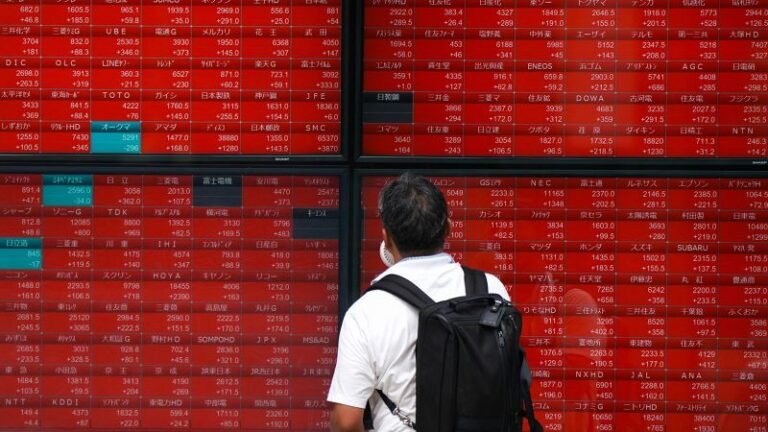Hong Kong
CNN
—
Japanese shares soared in early trading on Tuesday, clawing back most of their record losses from the previous day and underpinning a regional rally.
The benchmark Nikkei 225 index and the broader Topix were both about 9% higher. Elsewhere in Asia, South Korea’s Kospi rebounded by about 3%, while Taiwan stocks regained 4%. They all suffered major losses during the previous trading session.
The bounce in Japan is “typical after a market crash,” Neil Newman, head of strategy at Astris Advisory in Tokyo, told CNN. “Importantly: Fundamentals are sound, the economy is doing fine, there is no evidence of abandoning Japanese equities.”
One of the top gainers on Tuesday was soy sauce maker Kikkoman Corporation, which was trading about 21% higher after falling nearly 17% the previous day.
Losses like that led the Nikkei to close 12.4% lower on Monday in its largest one-day fall since October 1987. It lost 4,451, its biggest point drop in history. The plunge triggered a global market rout. All major Asian, European and US markets fell substantially.
Wall Street also took a beating with all three major indexes falling between 2.6% and 3.4% on fears the US economy was slowing faster than expected. But the tide is turning there too. The S&P 500 and Nasdaq futures, an indication of how the indexes are likely to open, bounced back in the hours after the close of the main trading session.
Growing worries about a recession in the US economy and the rapid unwinding of popular carry trades involving the yen had sent global markets into a tailspin starting Friday.
The surge in the yen, which started when the Bank of Japan (BOJ) signaled a hawkish tilt in monetary policy in recent weeks, forced many market participants to quickly unwind their yen carry trades, a popular investment strategy.
Decades of extremely low interest rates in Japan have seen many investors borrow cash cheaply there before converting it to other currencies to invest in higher-yielding assets. The undoing of this strategy is the major trigger for the market upheaval, said Stephen Innes, managing partner of SPI Asset Management.
Tokyo “represents the epicenter of carry trade unwinds, where the ripple effects were most acutely felt, exacerbating the turbulence and uncertainty for traders and investors alike,” he said.
On Monday, the yen hit a seven-month high against the US dollar at around 143. It pulled back slightly on Tuesday, down about 1% to 145.76.
In the United States, concerns are mounting that Friday’s dismal jobs report was another sign that the central bank has failed to manage the US economy, and that a significant slowdown was ahead. That was a major driver for the losses in New York.
In Japan, while there also concerns about the economy, the dynamic is different and there are few concerns about economic fundamentals, according to Newman, with Astris Advisory. Instead, all eyes are on the yen.
On Wednesday, the BOJ raised interest rates for the second time this year and announced plans to taper its bond buying. Traders expect more rate hikes to come later this year as the central bank tries to contain inflation.
“I think (the panic over the central bank decision) has been digested, but there are lingering concerns,” Newman said. “The big question now is will the BOJ follow through with another rate rise given all the criticism in the press. I believe they will and are not swayed by public or press opinion.”
More than half of what Japan produces is sold overseas, Newman added, in a process of offshoring that started in the 1980s with automobile production in the US.
What’s important for small- and medium-size companies that employ the bulk of Japan’s workforce is the high cost of raw materials and energy, which have been exacerbated by the weak yen, he said. That’s why the BOJ may be under pressure to bolster the Japanese currency.
Speaking on Tuesday, Japanese Prime Minister Fumio Kishida said it was important to make calm judgements about the market situation, according to Reuters. He reportedly shared an optimistic outlook for the economy, citing factors like the first rise in inflation-adjusted real wages in more than two years, which happened in June.


